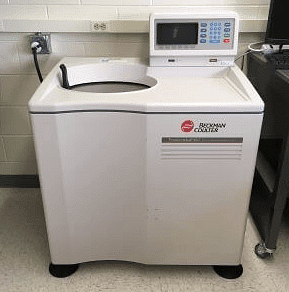UPSC Exam > UPSC Notes > Zoology Optional Notes for UPSC > Ultracentrifuge Essentials: Principles, Types, and Applications
Ultracentrifuge Essentials: Principles, Types, and Applications | Zoology Optional Notes for UPSC PDF Download
| Table of contents |

|
| Ultracentrifuge Principles |

|
| Types of Ultracentrifuge |

|
| Ultracentrifuge Components |

|
| Ultracentrifuge Operating Procedure |

|
| Uses of Ultracentrifuge |

|
| Ultracentrifuge Precautions |

|
Ultracentrifuge Principles
The ultracentrifuge operates based on the principles of centrifugation, applying additional forces to enhance sedimentation.
- It relies on the sedimentation principle, where denser particles settle faster than less dense ones under gravity.
- The ultracentrifuge rotates the sample, creating a centrifugal force perpendicular to the axis, causing particles to move differently.
- Larger, denser molecules move faster and towards the periphery of the tubes.
- Smaller, less dense molecules move slower and may remain suspended or float toward the center.
- After centrifugation, larger and denser particles form pellets at the bottom, while smaller and less dense particles remain in the supernatant or float on the surface.

Types of Ultracentrifuge
Ultracentrifuges serve various purposes and come in two main types:
1. Analytical Ultracentrifuge (AUC)
- Analytical ultracentrifuges are used for particle analysis.
- AUC quantitatively analyzes macromolecules in solutions.
- It determines sedimentation coefficients, offering insights into particle properties like shape, size, and mass.
- AUC employs three optical systems for real-time monitoring (absorbance, interference, fluorescence).
- Frequently used for characterizing biomolecules such as proteins and nucleic acids.
2. Preparative Ultracentrifuge
- Preparative ultracentrifuges isolate and separate particles in a sample through centrifugation.
- Analysis is performed after centrifugation, distinguishing them from analytical ultracentrifuges.
- These ultracentrifuges handle processes like density gradient centrifugation, differential centrifugation, and isopycnic centrifugation.
- Particles can be separated based on their density or size, helping determine their properties.
Ultracentrifuge Components
Ultracentrifuges consist of several essential components:
- Rotors: Ultracentrifuges use three types of rotors: vertical rotors, swinging bucket rotors, and fixed-angle rotors. Swinging bucket rotors are common in ultracentrifuges.
- Drive: The drive powers the rotor holding cells or tubes with the sample. It also includes features like temperature control.
- Optical Systems: Analytical ultracentrifuges feature optical systems (absorbance, interference, fluorescence) for real-time analysis.
- Gradient-Forming Device: Found in preparative ultracentrifuges, this device helps create density gradients.
- Refractometers: These devices measure the refractive index and are useful for specific ultracentrifuge applications.
- Fraction Collector: Used in preparative ultracentrifuges for collecting separated particles.
Ultracentrifuge Operating Procedure
The operation of an ultracentrifuge varies based on the type, whether analytical or preparative:
Analytical Ultracentrifuge:
- Small samples are placed in analytical cells within the ultracentrifuge.
- The ultracentrifuge operates, causing biomolecules to migrate radially from the center.
- The Schlieren optical system is used to determine the distance of molecules from the center.
- A graph is created to calculate molecular mass.
Density Gradient Centrifugation:
- A density gradient is prepared using sucrose layers.
- Samples are placed over the gradient, and the centrifuge is operated.
- Particles separate based on matching density with the medium.
- Fractions are collected.
Differential Centrifugation:
- The sample is homogenized in a buffer.
- After centrifugation, pellets form at the tube bottom, separated from supernatant.
- The supernatant is centrifuged at varying speeds to further separate particles.
- Particles are identified based on specific indicators.
Uses of Ultracentrifuge
Ultracentrifuges find applications in various fields:
- Preparative Ultracentrifuges: Used for pelleting cell organelles, nucleic acid separation, and more.
- Density Gradient Centrifugation: Separates nucleic acids.
- Analytical Ultracentrifuges: Detect and characterize macromolecules, assess molecular properties, and differentiate between molecular complexes.
- Determination of Particle Densities: Used to measure the densities of macromolecules.
- Purification: Prepares biological extracts by separating different components.
Ultracentrifuge Precautions
Ultracentrifuges are delicate instruments and require careful handling:
- Always follow the manufacturer's manual when operating the ultracentrifuge.
- Regularly inspect rotors for signs of corrosion and cracks.
- Ensure the volume of sample in tubes is equal when adding them to the rotor.
- Balance the number of tubes in the ultracentrifuge.
- Do not exceed the specified rotor speed.
- Keep the chamber lid closed during operation.
- Adhere to the manufacturer's rotor care guidelines to prevent damage.
The document Ultracentrifuge Essentials: Principles, Types, and Applications | Zoology Optional Notes for UPSC is a part of the UPSC Course Zoology Optional Notes for UPSC.
All you need of UPSC at this link: UPSC
|
198 videos|351 docs
|
Related Searches














